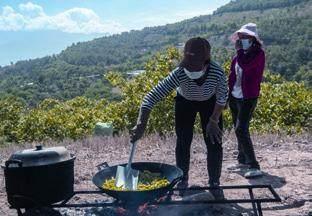Bouncing Back to Normal
2021-06-04ByWangHairong
By Wang Hairong


In Chenjia Village in Yunnan Province, about a dozen women were busy cooking at a temporary camp, washing and chopping up vegetables, stir-frying them in a pot on a small pile of charcoal while rice simmered in another pot.
They were preparing lunch for the entire village that had moved to the site after a 6.4-magnitude earthquake struck the area on the night of May 21. There were 15 tents altogether for a total of 67 residents, with one tent for each household. Soon, lunch was ready, cooked with rice, oil and other ingredients provided by the government as relief measures.
The government has not only set up tents and provided makeshift beds and quilts for each family, but also sent foodstuffs, drinking water and other daily necessities, 68-year-old Luo Zhihong, one of the villagers, said.
Chenjia, situated at the epicenter of the quake, saw most of its houses damaged while some had entirely collapsed.
Two in a row
Tremors began to jolt Yangbi Yi Autonomous County where Chenjia is located, about three days before the May 21 quake alarmed people across the country. There were fears about bigger quakes and sure enough, about four hours later, a 7.4-magnitude earthquake hit Qinghai Province in the northwest early on May 22. The epicenter was Maduo County in the Golog Tibetan Autonomous Prefecture. It was the largest jolt in China since an 8-magnitude earthquake devastated Wenchuan County in Sichuan Province in 2008.
However, since both the epicenters in Yunnan and Qinghai were sparsely populated, neither quake caused heavy casualties.
The Yangbi earthquake had led to three deaths and 32 injuries, according to Shi Shangkun, a health official of Dali Bai Autonomous Prefecture, which administers Yangbi. One died after a falling rock from the mountainside hit his truck, and the other two suffered injuries or a heart attack while trying to flee from danger during the tremor.
Some 190 houses had collapsed in the county, and 13,090 houses had been damaged, media reports said, quoting Yangbis earthquake relief headquarters. Some public infrastructures like reservoirs and bridges were also damaged.
A resident of Pingdi Village in Yangbi told the press that when the quake struck, his family of 10 had not gone to bed yet. When they saw the roof beams swaying, they ran out of the house, just before the two-story building made of wood and earth collapsed.
The earthquake in Qinghai, though more powerful, caused no death. It injured 18 and disrupted the lives of over 32,000 residents in Golog and Yushu Tibetan Autonomous Prefecture, but by May 24, 17 of those injured had been treated and discharged from hospital, according to Li Jun, an official with the provincial department of emergency management, at a press conference.
